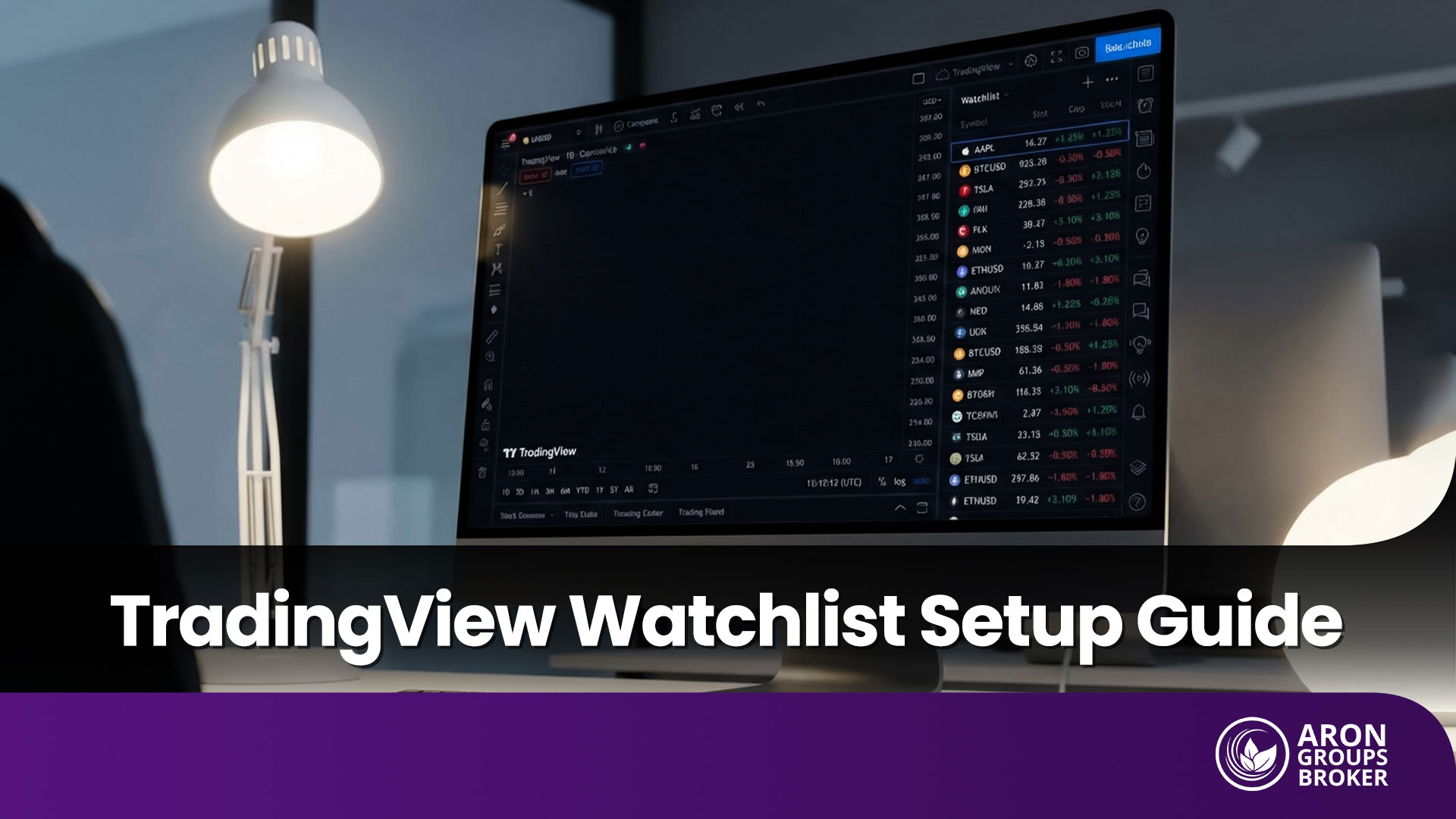In the highly volatile and complex world of Forex, traders are constantly seeking methods and strategies to accurately identify entry and exit points and capitalize on market swings. One of the key concepts used in the Smart Money strategy is Change of Character (CHoCH). In this article, we will provide a clear, practical explanation of CHoCH in Forex and examine how to use it in a Smart Money-based strategy.

- Use CHoCH as a filter, not a standalone signal; only act when it matches higher-timeframe bias and macro context.
- Create a CHoCH checklist (HTF bias, key level, volume, clean structure, RR ≥ 1:2) and skip any setup that fails one item.
- Automate CHoCH detection with scanners or scripts (MT4/5, TradingView) to systematically flag fresh structure shifts.
- Journal every CHoCH trade with screenshots and notes to spot where you mistake market noise for real structural change.
What Is Smart Money?
According to Investopedia, the Smart Money strategy refers to a set of trading methods and techniques used by professional traders and large financial institutions such as banks, investment funds, and high-net-worth investors.
The main goal of this strategy is to identify market movements and profit from the behaviour of large players who have a significant influence on prices. These participants, thanks to their large capital and access to advanced information and analytics, have the ability to steer the market, and the Smart Money approach aims to follow and mirror their behaviour.
One of the core principles in the Smart Money strategy is the focus on price movement and trading volume. Traders who follow this approach rely less on traditional indicators and instead concentrate on price action and how the price interacts with key levels. For example, Smart Money traders pay close attention to:
- Breakouts of support and resistance levels;
- Reversal points in major trends.
These are often the zones where large investors start to enter or exit the market.
In the Smart Money framework, the concept of liquidity is crucial. Liquidity refers to areas on the chart where a large number of orders are clustered, such as major highs and lows or zones where retail traders have placed their stop-loss orders. Large investors often use these areas to enter positions, because the high liquidity allows them to execute sizeable orders with less visible impact on price.
For example, when the market approaches a resistance level, many retail traders may place sell orders there. However, large players may first push the price above that resistance so that:
- Pending sell orders of retail traders are triggered.
- Their stop-loss orders are also activated.
Then, by absorbing this liquidity, the large players can execute their own buy orders more efficiently.
Overall, the Smart Money strategy is built on the idea that markets are heavily influenced by powerful participants. Retail traders can improve their results by analysing the actions of these players and aligning their trades with them. Instead of focusing primarily on technical indicators, Smart Money traders focus on real market behaviour and the flow of institutional capital, using more advanced analysis to make better-informed trading decisions.
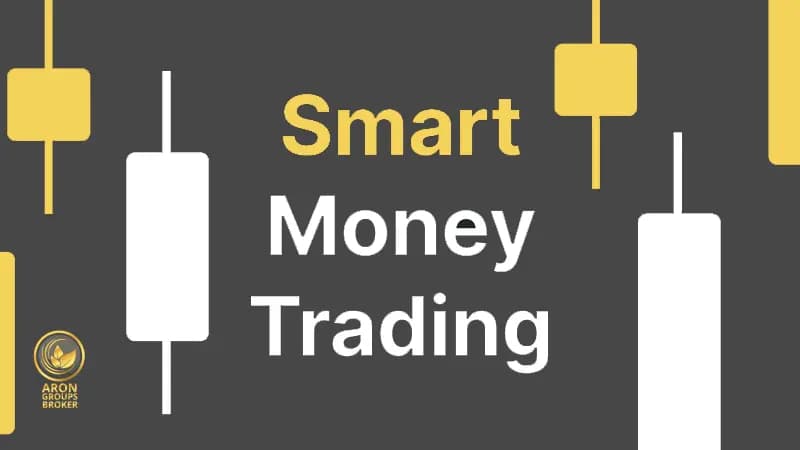
What Is CHoCH?
CHoCH is the abbreviation of “Change of Character”, and it refers to a change in market structure that signals a possible end to the current trend and the beginning of a new one. Professional traders, especially those who use Smart Money concepts, use CHoCH as a tool to identify potential market reversal points.
Simply put, a CHoCH occurs when the market shifts from one trending condition (bullish or bearish) to another. This change in the “character” of the market can be a signal to enter or exit trades.
Key Difference Between CHoCH and Break of Structure (BOS) in Smart Money
In Smart Money strategies, there are two important concepts: BOS (Break of Structure) and CHoCH (Change of Character). These two are sometimes confused because both involve breaking a price level, but they have different meanings and uses.
- BOS happens when the market continues to move in line with the current trend.
For example, in an uptrend, if the price breaks above a previous high, this shows that the bullish trend is still strong. This type of break is considered a confirmation of trend continuation. - CHoCH, on the other hand, is the first sign that the trend might be changing.
In the same uptrend, if instead of breaking a previous high, the price breaks below the previous low, this is the first sign of weakness in the structure. This change in behaviour is called a Change of Character and can be an early warning of a potential downtrend.
In simple terms:
BOS is the continuation of the old story; CHoCH is the beginning of a new story.
Understanding this difference is crucial for traders who work with Smart Money concepts, because:
- A BOS is usually a signal to continue trading in the direction of the existing trend.
- A CHoCH can be the start of a significant change in market direction.
The CHoCH Strategy
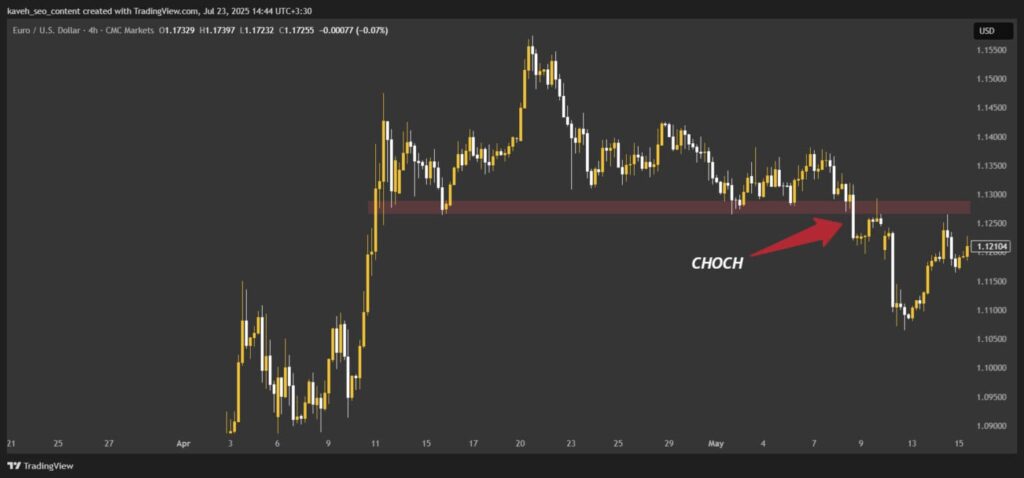
To better understand what CHoCH is and why it matters, let’s look at a practical example.
In the chart above, we first see a healthy uptrend: The market is consistently forming Higher Highs (HH) and Higher Lows (HL). This structure reflects strong buying pressure and a sustained bullish trend.

Many CHoCH signals are driven by liquidity hunts, where price temporarily sweeps stops above or below key levels before reversing.
The point marked with a red arrow and labelled “CHoCH” is where the market’s character changes. At that moment, the price breaks below the previous low, dropping under the last HL, and the bullish structure is violated.
This break of the low is a key signal because it shows that selling pressure has entered the market, and buyers may no longer be in control. If this change in structure continues (for example, by forming a lower high or breaking more support levels), we can say that a new downtrend is likely forming.
That is why this point is called a Change of Character (CHoCH): The market shifts from one state to another, for example, from bullish to bearish.
Types of CHOCH: Major vs. Minor
In Smart Money–based analytical frameworks, not all Changes of Character (CHOCH) are the same. Depending on the timeframe, the strength of the move, and where it occurs within the broader market structure, CHOCH can be divided into two main categories: Major CHoCH and Minor CHoCH.
Understanding this distinction helps traders differentiate between a short-term correction and a true trend reversal.

Major CHoCH
A Major CHoCH signals a shift in the primary market trend. This is where the dominant structure (for example, an established uptrend or downtrend) is clearly and decisively broken. This type of CHoCH usually appears on higher timeframes (such as H4 or Daily) and is often accompanied by:
- High trading volume;
- Strong candles;
- Reactions at key areas on the chart.
Key characteristics:
- Indicates a change in the broader market trend;
- Clear break of the previous strong structure with confirming candles;
- Reaction at important supply/demand zones or Order Blocks;
- Visible on higher timeframes or at major phase-shift points in the market.
Minor CHoCH
A Minor CHoCH occurs more within the existing structure and typically reflects a short-term shift or internal correction inside the main trend. This type of CHoCH is more common on lower timeframes (such as M5 or M15) and often provides a temporary signal that either:
- Marks a correction, or
- Creates an opportunity to re-enter the direction of the main trend.
Key characteristics:
- Temporary change or correction within the primary trend;
- Usually visible on lower timeframes;
- Reaction to short-term liquidity or a small break in structure;
- Can be used for entry refinement on lower timeframes.

Distinguishing major from minor CHoCH is crucial, as CHoCH at key areas with volume confirmation may signal trend reversals, while those in secondary zones usually indicate short-term pullbacks.
Step-by-Step Guide to Identifying CHoCH on the Price Chart
Understanding the concept of CHoCH is not enough on its own; what really matters is how to identify it on the price chart accurately. In this section, we explain the steps to spot CHoCH in both bearish and bullish situations, so you can correctly detect key zones in real market conditions and use them for low-risk, high-precision entries.
Identifying a Bearish CHoCH: Shift from Uptrend to Downtrend
In a bullish structure, the market is consecutively forming Higher Highs (HH) and Higher Lows (HL). This structure shows that buyers are in control and the uptrend is intact. At some point, however, the market may undergo a change of character, and signs of selling pressure may start to appear.
To detect a bearish CHoCH, you should first:
- Identify the last valid Higher Low (HL) that led to the formation of the next Higher High (HH).
This low usually acts as a reliable support level within the uptrend and plays a crucial role in maintaining the structure.
If price breaks this low decisively and a candle closes below it, this can be considered the first warning that a new downtrend may be starting.
At this point, a bearish CHoCH has occurred, because:
- For the first time, the market fails to continue the bullish structure
- A key level (the last HL) is broken to the downside
A very important detail here is the candle close below the previous low. If only the wick of the candle dips into that area, but the closing price does not end up below the level, the validity of the CHoCH is questionable. Only when the break is confirmed by a proper close below the level can it be treated as a genuine change in structure.
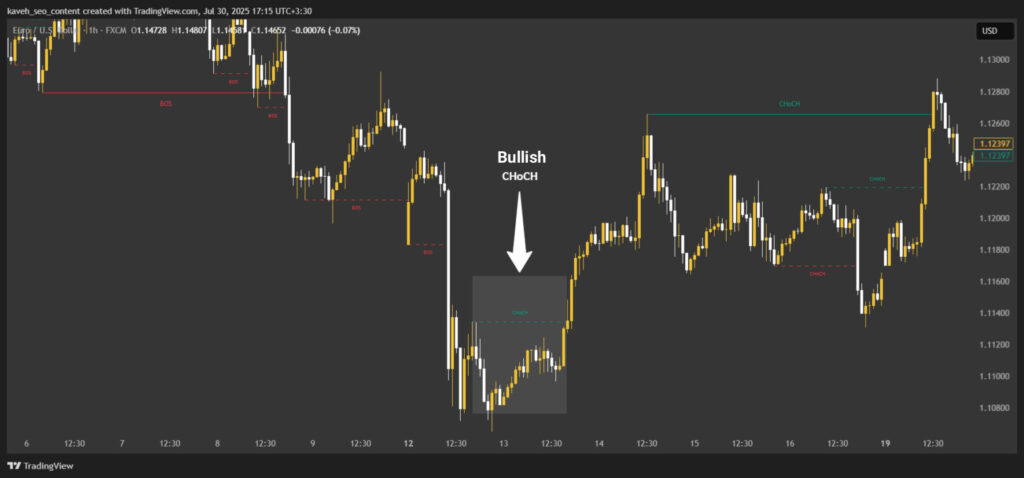
Identifying a Bullish CHoCH: Shift from Downtrend to Uptrend
In a bearish structure, the market is generally forming Lower Lows (LL) and Lower Highs (LH). This sequence indicates that sellers are in control. To identify a change of character, you must first pinpoint the last valid Lower High (LH) that led to the formation of the next Lower Low (LL).
When price breaks this key high to the upside, and a candle closes above it, it means the bearish structure has been violated. The market has failed to print a new lower high and instead has pushed beyond the previous resistance. In this situation, a bullish CHoCH has occurred, and the probability of a new uptrend increases.
Here, too, the closing price above the broken level is critical:
- A simple touch or brief spike above resistance is not enough;
- A valid candle close, preferably with a relatively large body, above the level, is needed to confirm the change of character.
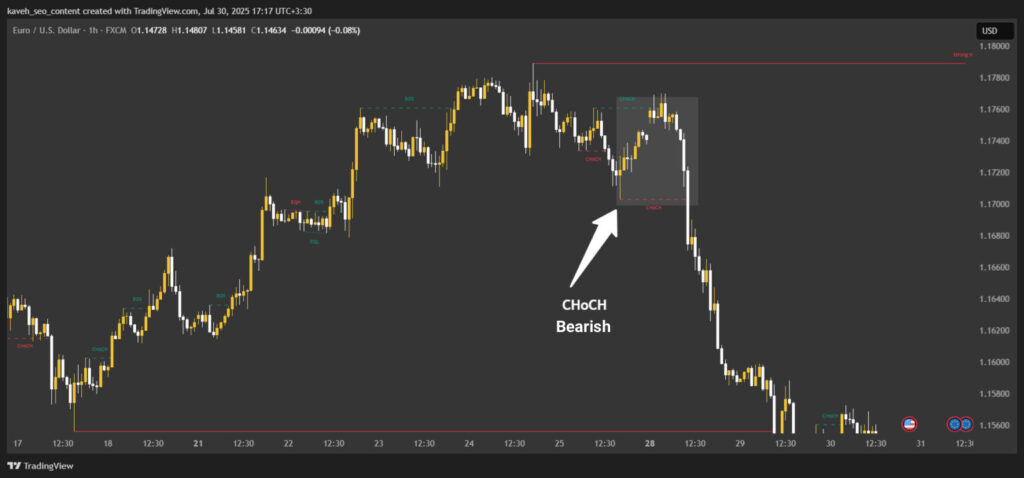
Why Does the Candle Close Matter?
In both bearish and bullish CHoCH setups, the candle close beyond the broken level is the main confirmation criterion. The close shows that the breakout is real and that the market genuinely intends to move away from the previous structure.
Many false breakouts (fakeouts) happen when the price only pierces the level intraday but eventually closes back inside the prior structure. Such moves are misleading and can result in poor trading decisions.
Confirming the break with a proper candle close, especially when supported by higher trading volume or a strong candle, significantly strengthens the CHoCH signal and increases the probability of a successful trade.

Genuine CHoCHs often align with sudden shifts in market momentum, identifiable through candle structure, wick spikes, or speed of price rejection.
Practical Example of a Bullish CHoCH (Shift from Downtrend to Uptrend)
To make the concept of a bullish CHoCH clearer, let’s walk through a complete trading scenario:
- Identify the initial downtrend
The market is printing Lower Lows (LL) and Lower Highs (LH). This structure indicates that sellers are in control. - Mark the last valid LH
The last Lower High formed before the most recent Lower Low (LL) is considered a key resistance level. - Break of structure and occurrence of CHoCH
Price breaks above this last LH with strength and closes above it.
This is the first sign of a change of character, showing that sellers have likely lost control. - Wait for the pullback
After the breakout, the price typically pulls back to the broken LH level or to a bullish Order Block in that area. This pullback offers a favourable opportunity to look for buy entries.

- Define the entry point The entry is placed in the pullback zone (near the Order Block or the broken resistance turned support). This area is often the best place to enter with minimal risk.
- Risk management (Stop Loss) The stop loss is set slightly below the recent Low (LL). If this low is broken, the analysis is invalidated, because a new uptrend would then be less likely.
- Target setting (Take Profit) Take profit levels can be set at the next resistance zones or previous market highs. Typically, a risk-to-reward ratio of at least 1:2 is recommended.
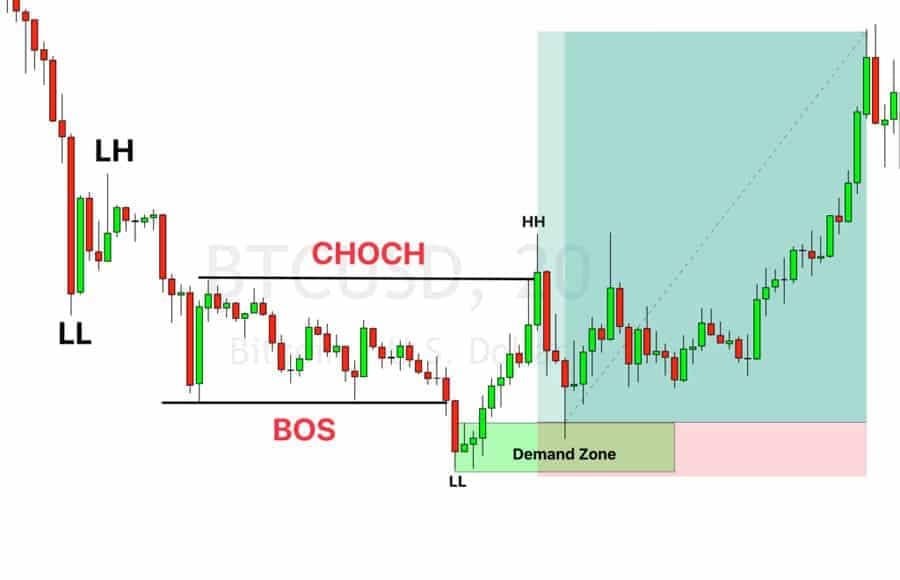
Steps to Identify CHoCH
The concept of CHoCH (Change of Character) is one of the key tools for detecting trend reversals in the Forex market. This shift in market character helps traders identify major reversal points and use them for optimal trade entries and exits. Below, we explain the steps for identifying CHoCH precisely and in a step-by-step manner:
1. Identify the Current Market Trend
The first step in detecting CHoCH is to determine the current market trend. The market trend can generally be classified into three main types:
- Uptrend: Price is broadly forming higher highs and higher lows.
- Downtrend: Price is forming lower highs and lower lows.
- Sideways / Range-bound: Price moves horizontally within a relatively narrow range, creating clear highs and lows inside that band.
Recognizing the current trend helps you understand whether the market is still continuing its previous direction or is likely on the verge of a change.
2. Define the Current Market Structure
After identifying the trend, you need to closely examine the market structure. This involves marking the highs (High) and lows (Low) on the chart.
Pay attention to the following:
- In an uptrend, price consistently forms higher highs and higher lows.
- In a downtrend, price consistently forms lower highs and lower lows.
By marking these points, you can clearly see the active structure of the market and determine whether the trend is continuing or if signs of a potential shift have started to appear.
3. Detecting a Change in Market Structure
A CHoCH occurs when the existing market structure changes. This usually happens when the current trend suddenly fails.
For example:
- In an uptrend, the market keeps forming higher highs and higher lows.
- At some point, price may print a lower low (LL) compared to the previous low. This is the first sign of weakness in the uptrend.
- Then, price forms a lower high (LH) compared to the previous high, which suggests the possible end of the uptrend and the start of a downtrend.
This shift in structure (i.e., forming lower lows and lower highs within an uptrend) is exactly what we refer to as CHoCH, and it usually marks a key reversal area in the market.
However, to identify the exact CHoCH zone that price may later retest as support or resistance (for example, via a pullback), you should focus on:
- The area around the last low formed in an uptrend, or
- The area around the last high formed in a downtrend.
These zones often act as key reaction levels. For better understanding, you would normally refer to the related chart examples.
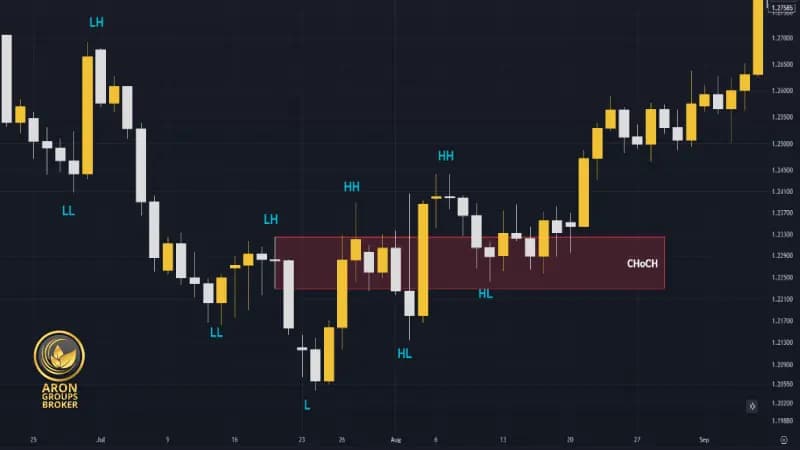
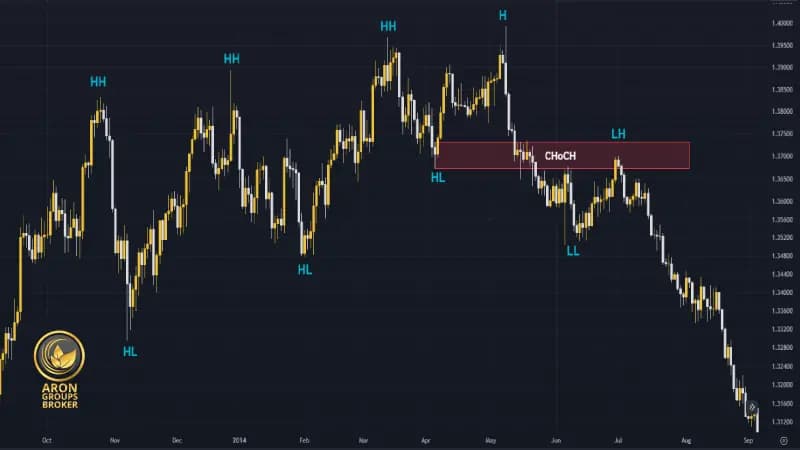
4. Confirming CHoCH with Breaks of Key Levels
Once you’ve identified a change in structure, the next step is to check whether key market levels have been broken. These key levels include important support and resistance zones where price has previously reacted multiple times.
In a CHoCH-based strategy, the break of such key levels is highly important because it can serve as confirmation of a trend change.
For example:
- If the market is in an uptrend, and in addition to forming a lower low, it also breaks a major support level, this strengthens the signal that the uptrend has likely ended and that a new downtrend may be starting.
Identifying these key levels and observing their break in the vicinity of a CHoCH can give traders greater confidence when entering trades.
5. Confirming CHoCH with Trading Volume
Trading volume is another important factor in confirming a CHoCH. Typically, volume increases around CHoCH points. This rise in volume indicates that large market participants are entering or exiting positions, which in turn drives the trend change.
For example:
- When the market is in an uptrend, and a change in structure occurs along with a break of support levels, an increase in trading volume confirms that this move is likely driven by large investors and that the probability of a continued downtrend is higher.

For this reason, volume can be used as a confirming tool alongside other factors when analysing CHoCH.
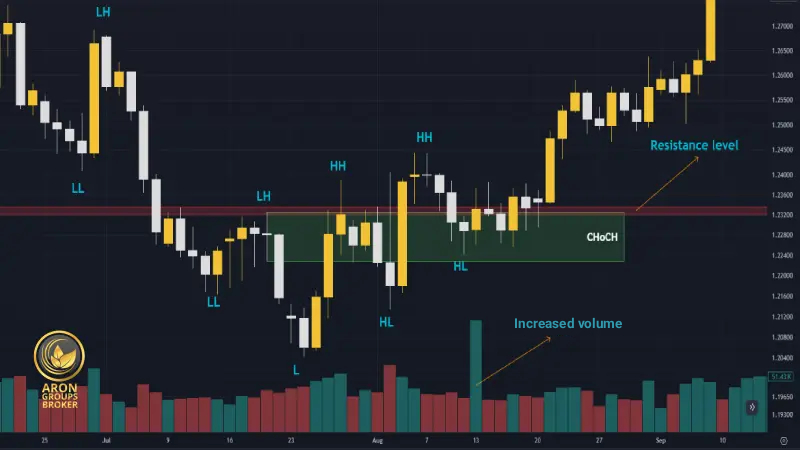
Using the Volume Indicator to Confirm a CHoCH Signal
One effective way to improve the accuracy of CHoCH signals is to use the Volume indicator as a confirmation tool. In many cases, changes in market structure are more reliable when they are accompanied by a noticeable increase in trading volume.
When a candle causes a CHoCH (whether bullish or bearish), checking the Volume indicator can help the trader see whether this structural change is driven by the participation of large market players or not. If, at that moment, the volume bar is significantly higher than the average volume of previous candles, this is a strong sign that the trend change is valid.
Practical example:
Suppose on the EUR/USD chart, the market is in an uptrend, and the last valid low is suddenly broken (bearish CHoCH). If, on the same candle that breaks this low, the volume bar on the Volume indicator is much higher than the recent average, we can conclude that heavy selling pressure (on the supply side) has entered the market.
This spike in volume shows that the structural change is not just a temporary move or short-term manipulation, but is more likely the beginning of a strong downtrend.
Using this method, especially in combination with identifying key levels and higher timeframes, can significantly increase the success rate of CHoCH-based trades.
How to Trade with CHoCH
CHoCH means the market’s behaviour is shifting. When this happens, the previous trend (bullish or bearish) is weakening, and a new trend may be starting. To trade more confidently, simply seeing a CHoCH is not enough; you should also pay attention to important areas such as Order Blocks or Fair Value Gaps (FVGs).
Identifying CHoCH on the Chart
On the EUR/USD pair, the market is initially in an uptrend, forming higher highs and higher lows.
- A key high is formed at 1.39950.
- After that, the market prints a lower low at 1.35000, which is the first sign of weakness in the uptrend.
- Then a lower high forms at 1.37000, which confirms the Change of Character (CHoCH) and shows that a downtrend has started.
Choosing the Entry Point
Once the CHoCH is confirmed, we do not enter the trade immediately. It is better to wait for the price to retrace upward and reach:
- The last bullish candle before the drop (bearish Order Block), or
- The FVG zone is between 1.36700 and 1.36900.
This area is the best place to enter a short position.
- Entry price: 1.36850
Setting the Stop Loss
The stop loss should be placed at a level that, if reached, clearly shows that the analysis was wrong. In this example, if the price moves above the Order Block, it means the downtrend has not been confirmed.
Therefore, the stop loss is set slightly above that zone:
- Stop Loss: 1.37600
Setting the Take Profit
For the take profit, it is better to target the next major support levels, areas where the price is likely to pause or react. In this example, a key support lies around:
- Take Profit: 1.34000
This level can be used as a logical exit point with profit.

Advantages and Disadvantages of the Smart Money Strategy and CHoCH
Like all market analysis styles, the Smart Money strategy and trading setups such as CHoCH have their own specific strengths and weaknesses. Below, we briefly review some of the main advantages and disadvantages of the Smart Money approach and the CHoCH trading setup.Advantages of the Smart Money Strategy and CHoCH
Using the Smart Money strategy and CHoCH offers several benefits, including:- Timely identification of trend reversals CHoCH helps traders spot potential trend changes at an early stage. This makes it easier to enter trades at better prices and with lower risk. By accurately identifying CHoCH, traders can capture a larger portion of a new trend from its beginning.
- Improved accuracy of analysis The Smart Money strategy, in general, and CHoCH in particular, help traders analyse the market based on precise structural changes and obtain clearer trading signals. Instead of relying mainly on common technical indicators, this approach focuses on price structure and order flow, which leads to deeper, more meaningful analysis.
- Applicability across multiple timeframes The Smart Money strategy can be applied to different timeframes, from short-term to long-term. Traders can use it in various contexts, from day trading to swing trading and position trading.
- Alignment with Smart Money flows (large financial institutions) This strategy aims to interpret the behaviour of large investors and institutions, who often play a major role in driving price movements. By identifying the actions of these big players, retail traders can position themselves to benefit from large directional moves in price.
Disadvantages of the Smart Money Strategy and CHoCH
The Smart Money strategy and CHoCH, like any other analytical style, also have limitations. Some of the main drawbacks are:- Requires substantial experience and knowledge Trading with CHoCH and Smart Money concepts demands solid technical analysis skills and a deep understanding of market behaviour. Beginner traders may struggle to correctly identify CHoCH zones or interpret key levels, which can lead to poor decisions.
- Complexity in identifying key levels Accurately determining important support and resistance zones and analysing volume at CHoCH points can be challenging. If a trader fails to correctly mark these key levels, trades may carry higher risk and yield unfavourable outcomes.
- Vulnerability in highly volatile markets In very volatile markets, CHoCH can be misidentified, and the price may quickly reverse. In such conditions, false signals are more likely, which can cause traders to enter positions at the wrong time.
- Lower effectiveness in sideways (range-bound) markets CHoCH and the Smart Money strategy work best in markets with strong trends. In sideways or range-bound markets, they may not provide reliable signals. When the price is moving horizontally within a range, CHoCH may fail to offer precise entry and exit points.
Additional Guidelines for Using the Smart Money Strategy and CHoCH
To maximise your success when applying the Smart Money strategy and the CHoCH trading setup, it is important to keep the following points in mind:Setting a Stop Loss
In every trade, even if the CHoCH signal is correctly identified, there is always a chance of failure. That is why defining a Stop Loss is crucial.- The stop loss should be placed at key market levels, such as important support or resistance zones, so that if the trend fails, your loss is limited.
- It is also important to set your stop loss in a way that the risk per trade does not exceed 1-2% of your total capital.
Determining Position Size
The position size of each trade should be determined based on the amount of risk you are willing to take.- The larger the stop-loss distance (the further it is from your entry), the smaller the position size should be to keep risk under control.
- Always assess the Risk-to-Reward Ratio before entering any trade.
- A risk-to-reward ratio of 1:2 or better is generally recommended.
Avoid Adding to Losing Positions
If a trade moves into a loss, you should not add to that losing position in an attempt to “average down” or cover potential losses. This approach often leads to larger drawdowns and deeper losses.Avoid Premature Entries
One common mistake among traders is entering a trade before CHoCH is fully confirmed.- You should wait until the market has clearly changed its structure (for example, by forming a lower high or lower low in an uptrend, or the reverse in a downtrend) and then take action.
- Typically, after a confirmed break of support or resistance and a valid confirmation of the breakout, you can open a position with greater confidence.
Confirmation with Trading Volume
An increase in trading volume at CHoCH points can serve as confirmation of the strength of the trend change.- If a CHoCH is accompanied by rising volume, the probability that the signal is valid increases.
- If the structural change occurs on declining volume, the signal may be weaker, and the trade may involve higher risk.
Appropriate Timeframe Selection
Using CHoCH on higher timeframes generally provides more accurate and stronger signals.
- On lower timeframes, you are more likely to see noise and false signals.
- A good approach is to first confirm the CHoCH on a higher timeframe (for example, the 4-hour or daily chart) and then look for precise entry points on lower timeframes.
Conclusion
The CHoCH concept is one of the key tools within the Smart Money strategy. It helps traders identify critical changes in market structure and take advantage of price swings more effectively. By learning and mastering CHoCH, you can make better trading decisions and operate more efficiently in the Forex market.
It is important to emphasise that using CHoCH in combination with other technical analysis tools and strict risk management can significantly increase your chances of success in trading.
Source: TradingView, FXOpen





























